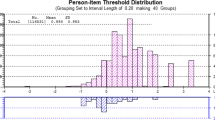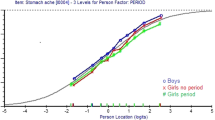Abstract
Although there is an increasing focus on trend analyses of adolescent mental health, yet too little attention is paid to the methodological challenges and pitfalls inherent in this type of analyses. The purpose of the study is to analyse the psychometric properties of a Finnish instrument on psychosomatic problems, with a major focus on Differential Item Functioning (DIF) across time. Questionnaire data collected in 1994, 1998, 2006 and 2014 among Finnish schoolchildren in grade 9 (15-year-olds) as part of the Health Behaviour in School-aged Children (HBSC) study were utilised. The polytomous Rasch model was used to examine the psychometric properties of a composite measure of psychosomatic problems. The results clearly indicate that the composite measure on psychosomatic problems consisting of nine items does not work invariantly over time. In particular, the item depressed shows DIF across years of investigations. This item works quite differently at the first year of investigation compared to the last year showing higher expected values 2014 (=less frequent problems) than 1994. This DIF affects the person measure of change in psychosomatic problems between 1994 and 2014. Resolving the item depressed for year of investigation DIF, or removing it, increases the difference in person mean values between the two years, implying increasing psychosomatic problems over time. Since the DIF affects the trend results, different options to address the problems need to be considered. Removing the item depressed would bring the Finnish measure of psychosomatic problems in better accordance with the content of the questions on psychosomatic problems in the international HBSC protocol in which the item depressed is not included.





Similar content being viewed by others
References
Andrich, D. (1978). A rating formulation for ordered response categories. Psychometrika, 43(4), 561–573.
Andrich, D. (2011). Rating scales and Rasch measurement. Expert Review of Pharmacoeconomics & Outcomes Research, 11(5), 571–585.
Andrich, D. (2013). The Legacies of R. A. Fisher and K. Pearson in the application of the polytomous rasch model for assessing the empirical ordering of categories. Educational and Psychological Measurement, 73(4), 553–580.
Andrich, D., & Hagquist, C. (2012). Real and artificial differential item functioning. Journal of Educational and Behavioral Statistics, 37(3), 387–416.
Andrich, D., & Hagquist, C. (2015). Real and artificial differential item functioning in polytomous items. Educational and Psychological Measurement, 75(2), 185–207. doi:10.1177/0013164414534258
Andrich, D., Sheridan, B., & Luo, G. (2014). RUMM2030: A windows interactive program for analysing data with Rasch unidimensional models for measurement. Perth: RUMM Laboratory.
Bland, J. M., & Altman, D. G. (1995). Multiple significance tests: the Bonferroni method. British Medical Journal, 310, 170.
Bor, W., Dean, A. J., Najman, J., & Hayatbakhsh, R. (2014). Are child and adolescent mental health problems increasing in the 21st century? A systematic review. Australian and New Zealand Journal of Psychiatry, 48(7), 606–616. doi:10.1177/0004867414533834.
Cieza, A., Oberhauser, C., Bickenbach, J., Jones, R. N., Üstün-Bedirhan, T., Kostanjsek, N., et al. (2015). The English are healthier than the Americans: really? International Journal of Epidemiology, 44(1), 229–238. doi:10.1093/ije/dyu182.
Currie, C. et al. (Eds) (2012). Social determinants of health and well-being among young people. Health Behaviour in School-aged Children (HBSC) study: International report from the 2009/2010 survey. Copenhagen: WHO Regional Office for Europe. (Health Policy for Children and Adolescents, No. 6).
Finnish National Board of Education. (2014). National core curriculum for basic education 2014. Helsinki: Finnish National Board of Education.
Hagquist, C., & Andrich, D. (2004). Is the sense of coherence-instrument applicable on adolescents? A latent trait analysis using Rasch-modelling. Personality and Individual Differences, 36(4), 955–68. doi:10.1016/S0191-8869(03)00164-8
Hagquist, C., & Andrich, A. (2015). Determinants of artificial DIF – a study based on simulated polytomous data. Psychological Test and Assessment Modeling, 57(3), 342–376.
Hagquist, C., Bruce, M., & Gustavsson, J. P. (2009). Using the rasch model in nursing research: An introduction and illustrative example. International Journal of Nursing Studies, 46(3), 380–93. doi:10.1016/j.ijnurstu.2008.10.007
Kreiner, S., & Christensen, K. B. (2014). Analyses of model fit and robustness. A new look at the PISA scaling model underlying ranking of countries according to reading literacy. Psychometrika, 79(2), 210–231. doi:10.1007/s11336-013-9347-z.
Masters, G. N. (1982). A Rasch model for partial credit scoring. Psychometrika, 47(2), 149–174.
Ottová-Jordan, V., Smith, O. R., Gobina, I., Mazur, J., Augustine, L., Cavallo, F., et al. (2015). Trends in multiple recurrent health complaints in 15-year-olds in 35 countries in Europe, North America and Israel from 1994 to 2010. European Journal of Public Health, 25(2), 24–27. doi:10.1093/eurpub/ckv015.
Paakkari, L., & Välimaa, R. (2013). Ethical issues in the teaching and learning of health topics in schools: the conceptions of teacher trainees. Teaching and Teacher Education, 34, 66–76. doi:10.1016/j.tate.2013.04.004.
Ravens-Sieberer, U., Erhart, M., Torsheim, T., Hetland, J., Freeman, J., Danielson, M., & Thomas, C. (2008). An international scoring system for self-reported health complaints in adolescents. European Journal of Public Health, 18(3), 294–299. doi:10.1093/eurpub/ckn001.
Statistics Finland (2014). Preliminary population statistics. Helsinki: Official Statistics of Finland, 2014, March. http://tilastokeskus.fi/til/vamuu/2014/03/vamuu_2014_03_2014-04-24_en.pdf. Accessed 21 Oct 2015.
Acknowledgments
The research was funded by Forte: the Swedish Research Council for Health, Working Life and Welfare (Program grant number: 2012–1736).
A previous version of this paper was presented at the 7th Excellence in Pediatrics Conference, 10–12 December 2015, London UK.
Author information
Authors and Affiliations
Corresponding author
Appendix
Appendix
Rights and permissions
About this article
Cite this article
Hagquist, C., Välimaa, R., Simonsen, N. et al. Differential Item Functioning in Trend Analyses of Adolescent Mental Health – Illustrative Examples Using HBSC-Data from Finland. Child Ind Res 10, 673–691 (2017). https://doi.org/10.1007/s12187-016-9397-8
Accepted:
Published:
Issue Date:
DOI: https://doi.org/10.1007/s12187-016-9397-8




